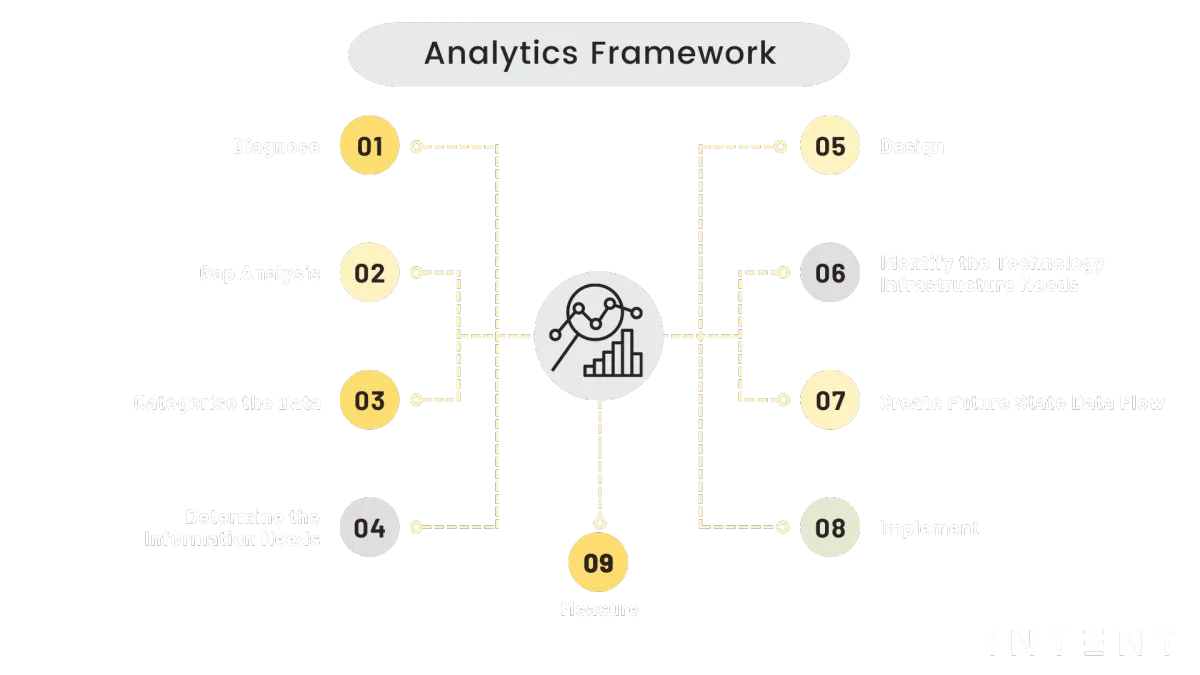THROW YOUR REPORTing
methods IN A BIN, USE LIVE
DASHBOARDS instead.
THROW YOUR REPORTING
METHODS IN A BIN, USE LIVE
DASHBOARDS INSTEAD.
Information management is the implementation of processes, roles, controls and metrics to effectively manage information and data. This includes collecting, storing, curating, dissemination, archiving and destruction of documents images, drawings and others sources of information. A major part of the Intent Information Lens is the curating of data to create information in the form of Analytics.
Analytics is a primary focus on the topic of Information as once Information is managed in an optimal way - whether that be the collection and storage of data, digitisation of physical documents or creating naming conventions to organise your data - it becomes reliable. Reliable data can then be dissected and drawn upon to create meaningful analytics which is used by a business for decision making, communication, efficiency and insight.
Many organisations prioritise the implementation of Business Intelligence systems prior to optimising their data and that is a perilous mistake. Creating analytics based on unreliable or misleading data leads to poor decision-making and miscommunication. It is imperative that data and information are stored logically, are easy to access, and secure and there is one source of truth.
Leaders should prioritise analytics as it can simplify otherwise complex decision-making in the business, not only saving time but it can also increasing accuracy. Secondly, analytics are at your fingertips. Rather than checking a statistic or insight once a quarter, the information is ready to digest at any moment. It all leads to more effective leadership so that there is time to focus on the abundance of other things that they are responsible for.
Analytics is of course, only as useful as they are created to be. Metrics and dashboards that are not planned and considered have the risk of being misleading and might actually be worse than having no analytical reporting at all. Metrics should provide insight and dashboards should tell a story. Analytics should be curated on a reliable Business Intelligence tool.
The world runs on instant information, it is up to organisations whether they want to be living in the dark or
have a chance at being a front-runner in their space.
Some facts about data and analytics in business

5X
Companies who use data to make fact-based decisions find the decision-making process 5 times faster.
55%
55% of businesses have dark data. Lots of organisations collect data however more than half of them don’t analyse it. That is an alarming loss of insights businesses could be leveraging.


1300%
The average ROI for enterprises using business intelligence and analytics is 1300%. Studies show that whoever controls the data, controls the market. There is much to gain by implementing business intelligence systems.
23X
Data-driven companies are 23 times more likely to acquire customers. Big data leads to big results and it is also found that companies who are data-driven are also 6 times more likely to retain their customers.


5X
Companies who use data to make fact-based decisions find the decision-making process 5 times faster.

55%
55% of businesses have dark data. Lots of organisations collect data however more than half of them don’t analyse it. That is an alarming loss of insights businesses could be leveraging.

1300%
The average ROI for enterprises using business intelligence and analytics is 1300%. Studies show that whoever controls the data, controls the market. There is much to gain by implementing business intelligence systems.

23X
Data-driven companies are 23 times more likely to acquire customers. Big data leads to big results and it is also found that companies who are data-driven are also 6 times more likely to retain their customers.

Techniques
When creating Analytics, it is important to have 2 things established first and kept front of mind: The audience of the report and the purpose of the report/dashboard. Every metric and piece of information should be useful to the intended audience and meet the goal, otherwise, it will contribute to an overload of information.
Curating metrics is difficult - there are just so many options and different visualisations it can be hard to know what to rule in or what to rule out. The Intent Analytics Framework breaks down the best way to do this, but in essence, we suggest starting broad and then refining. That means, thinking of every metric possible that the audience could possibly want for the purpose of that dashboard/report, dividing those metrics into topics, and then deciding on the top 10 most useful metrics in each topic.
Some other things to consider when tackling analytics are:
Choosing the right Business Intelligence tool to visualise your analytics.
Naming your metrics properly, ensuring it includes a specific time period for that metric (e.g. this month; last quarter; current; etc).
Consider the context of the metric. Just because it relates to the purpose of the report/dashboard, does the information it provides present an accurate and contextualised picture to the audience?
Ensure the report or dashboard tells a story.
Make them visually appealing! Visual communication is key.
Information is power only if you can take action with it. Then, and only then, does it represent knowledge and, consequently power.
-Daniel Burrus, New York Times bestselling author, technology futurist, business adviser, author, and public speaker
Are you a Corporate Manager / Executive? C-Suite? A part of a Board of Directors / Founders? Entrepreneur? Family Business Owner? Start-Up?
We have the scaling intelligence and experience to know you will find great financial success through scale with INTENT. Most importantly however, we are especially seeking to collaborate with people that are inspired not just to make a difference to their organisation, but are willing to be part of our purpose of creating Opportunity For Humans.
We know it only takes one person and the choices they make, that make all the difference for so many people.
Are you a Corporate Manager / Executive? C-Suite? A part of a Board of Directors / Founders? Entrepreneur? Family Business Owner? Start-Up?
We have the scaling intelligence and experience to know you will find great financial success through scale with Intent. Most importantly however, we are especially seeking to collaborate with people that are inspired not just to make a difference to their organisation, but are willing to be part of our purpose of creating Opportunity For Humans.
We know it only takes one person and the choices they make, that make all the difference for so many people.
Scale is as easy as 1, 2, 3:
Intentional Action Starts Here
Scale is as easy as 1, 2, 3:
Intentional Action Starts Here
01
ASPIRE
02
ASSESS
03
ACTION
01
ASPIRE
Decide that you will scale with intent. Inform your organisation of its gaps, do the assessments, define the ambition, get prepared internally to make the ambition a reality.
02
ASSESS
Choose how involved you want to be in the scaling process. Assess whether your internal capabilities only need minimal support or comprehensive support. A shortage of skills is not a weakness, it is an opportunity to make scale easy.
03
ACTION
Take intentional action; simply start doing what is necessary. Achieving great scale is not luck, it is a series of actions. Communicate with us about the first priority. Use our skills to fill gaps you may have. Use our methodology to create a focused pathway. Then DO.
The Junkeer Scaling Model works, it incorporates everything the giants before you have done and delivers it to you in a practical step-by this-step approach.
These are the stories of others that have taken action to scale with Intent
OUR CLIENTS
Marc & Marcia Harding
CEO & CFO
Wholesale Horticultural Group
Ross Pearson
CEO
BARD AI
OUR ROLE MODELS
APPLE
Steve Jobs' leadership drove Apple's strategic vision which ultimately inspired the creation of ground breaking innovation.
Their customer centricity approach has customers buying things they didn't even realise they wanted.
Apple's heavy investment in its' technology ecosystem was so well built, it made it difficult for consumers to leave, so kept consuming more and more.
WHO GIVES A CRAP
Purpose led organisations like Who Gives a Crap aren't just noble in their vision of supporting causes well beyond business, they have also leaned in to the principle that purpose scales businesses strategically.
The CEO and founder Simon Griffiths openly shares “The biggest lesson I have learned is that doing good is good business,”.
Who Gives a Crap is an impact conscious organisation, they know to look for things of influence such as sustainability goals.
Google openly shares that its corporate values are centred around innovation.
However, their leadership is sophisticated enough to realise that for them to achieve their goals, they have to also attain innovation concept from external sources.
They have developed processes to search and outsource ideas.
To harness internal talent they have created a culture of curiosity and celebration of failure.
One of their processes is to make sure to they capture the data of their lessions learnt so this information can be used when taking on new projects.
AMAZON
The leaders at Amazon don't credit its success to the genius of one single leader, rather a series of structured principles and practices, which are executed diligantly and rigorously.
Amazon created a set of scaleable and repeatable processes in addition to 14 leadership principles, that helped them get where they are today.
Their obsession of being customer centric is one of their principles.
Their leadership look at developing long term stategies which they don't compromise for short term results.
Management look for strong talent and ensure they are developed within the company.
Joining our Scaling Program
Want to take a small leap forward? Our milestone-based program provides a clear guide for start-up founders, ensuring they take the most direct path to achieving their scaling ambition. By eliminating trial and error, guesswork, and uncertainty, we help build start-ups ready for the global stage.
Choose between our month-by-month or all-at-once program options. Regardless of your choice, the program content remains the same. You determine the pace at which you work on your start-up.

At INTENT Scaling, we believe the best opportunities start with a great conversation, not a high-pressure pitch.
Book a complimentary workshop to define your scaling ambition and decipher a specific scaling challenge with us.
Services
Contact Us
scale@intent.do
(03) 9544 4494 | 0421 089 979
Suite 31, Level 10/440 Collins St, Melbourne VIC 3000, Australia
CAPABILITY STATEMENT
© Copyright 2025. Intent Scale Pty Ltd. All rights reserved.
01
ASPIRE
Decide that you will scale with INTENT.
Inform your organisation of its gaps, do the assessments, define the ambition, get prepared internally to make the ambition a reality.
02
ASSESS
Choose how involved you want to be in the scaling process. Assess whether your internal capabilities only need minimal support or comprehensive support. A shortage of skills is not a weakness, it is an opportunity to make scale easy.
03
ACTION
Take intentional action; simply start doing what is necessary. Achieving great scale is not luck, it is a series of actions. Communicate with us about the first priority. Use our skills to fill gaps you may have. Use our methodology to create a focused pathway. Then DO.
These are the stories of others that have taken action to scale with INTENT
OUR CLIENTS
Marc & Marcia Harding
CEO & CFO
Wholesale Horticultural Group
Ross Pearson
CEO
BARD AI
OUR ROLE MODELS
APPLE
Steve Jobs' leadership drove Apple's strategic vision which ultimately inspired the creation of groundbreaking innovation.
Their customer-centricity approach has customers buying things they didn't even realise they wanted.
Apple's heavy investment in its' technology ecosystem was so well built, it made it difficult for consumers to leave, so keep consuming more and more.
WHO GIVES A CRAP
Purpose led organisations like Who Gives a Crap aren't just noble in their vision of supporting causes well beyond business, they have also leaned in to the principle that purpose scales businesses strategically.
The CEO and founder Simon Griffiths openly shares “The biggest lesson I have learned is that doing good is good business,”.
Who Gives a Crap is an impact-conscious organisation, they know to look for things of influence such as sustainability goals.
Google openly shares that its corporate values are centred around innovation.
However, their leadership is sophisticated enough to realise that for them to achieve their goals, they have to also attain innovation concepts from external sources.
They have developed processes to search and outsource ideas.
To harness internal talent they have created a culture of curiosity and celebration of failure.
One of their processes is to make sure to they capture the data of their lessions learnt so this information can be used when taking on new projects.
AMAZON
The leaders at Amazon don't credit its success to the genius of one single leader, but rather a series of structured principles and practices, which are executed diligently and rigorously.
Amazon created a set of scalable and repeatable processes in addition to 14 leadership principles, that helped them get where they are today.
Their obsession with being customer-centric is one of their principles.
Their leadership look at developing long-term strategies which they don't compromise for short-term results.
Management looks for strong talent and ensure they are developed within the company.
The Junkeer Scaling Model works, it incorporates everything the giants before you have done and delivers it to you in a practical step-by this-step approach.
Joining our Scaling Program
Want to take a small leap forward? Our milestone-based program provides a clear guide for start-up founders, ensuring they take the most direct path to achieving their scaling ambition. By eliminating trial and error, guesswork, and uncertainty, we help build start-ups ready for the global stage.
Choose between our month-by-month or all-at-once program options. Regardless of your choice, the program content remains the same. You determine the pace at which you work on your start-up.





